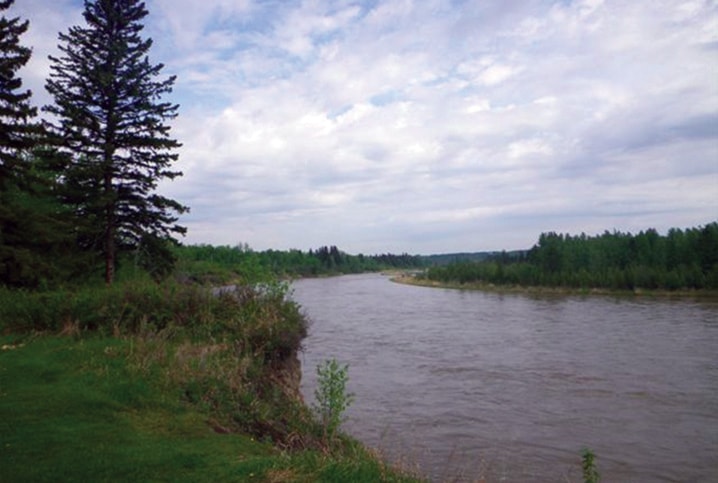We all love to fish on a warm, sunny day, but few aquatic insects like bright light and, among trout, only the cutthroat likes bluebird days.
So, the saddest thing I too frequently hear is an angler telling me he didn’t go out “because it was, like, raining?”
Recent water conditions had been perfect, and then it started to rain.
Why do I feel guilty just for advising several people recently to get out there at least for a look, maybe even some great fishing?
I was hoping that these anglers might beat the mud to their favourite spots and enjoy the fabulous insect hatches and fishing that so often reward anglers who persist in fishin’, maybe even singin’ in the rain.
This time it didn’t work: a moderate rain in Red Deer morphed into a million-dollar monsoon the farther west you went.
Even the usually clear North Raven River was high and murky, but it usually clears very quickly.
In 50 years, all my best fishing to trout rising for many of our super hatches has taken place when it was raining.
I have been fortunate to have caught the salmon fly hatch exactly right maybe a dozen times, and it was raining most of those times: on Prairie Creek, the Crowsnest, and the Madison in Montana.
I speculate that the rain tells the big females it is time for flying down on the water to lay their eggs, thus driving big trout into a feeding frenzy.
In England in 1987, as a member of the first Canadian team ever to enter the World Fly Fishing Tournament, I was sent for training to the Hampshire Avon River beat then owned by the Crown Inn at Everleigh, near the Salisbury Plain and Stonehenge. I was the only guest fishing on a cold, drizzly day.
But the brown trout and grayling were rising for what the Brits call “The Mayfly” (ephemera danica), almost identical to, and a close relative of our brown drake (ephemera simulans).
So well was I doing that, I handed a camera to a bystander and asked him to fire away the next time I caught a fish.
Eventually I was so cold and wet that my hands quit working. A long hot bath in a deep antique tub in my room at the Crown restored me sufficiently to enjoy a superb fresh Dover sole for dinner.
Then, on a dark and stormy Saturday night, the publican got me sampling his collection of rare single malts, and then introduced me for a chat with the local poachers who supplied the inn with pheasants and venison.
Brown drakes are generally late dusk emergers but will hatch mid-day, if it is dark enough; fortunately, I remembered that as I enjoyed a superb bowl of hot and sour soup for lunch years ago in Caroline. On the drive out, I was discouraged by the grey skies and showers and planned to head back home. But, on a hunch, I carried on to have a look. Well! The best brown drake hatch I have ever fished was in progress, in the rain on a favourite stretch of Prairie Creek, and I kept on catching big browns until they were so stuffed they quit eating.
On a rainy, sometimes snowy day at Last Chance, Idaho, my late fishing friend, Lloyd Graff and I were enjoying fishing the fabled western green drake (drunella grandis) hatch on Henry’s Fork of the Snake River, until Lloyd became the only angler ever known to have fallen into that even-bottomed gentle flow.
After a long saloon lunch, Lloyd was dry and warm enough to make the long hike into the Harriman Ranch stretch, where a heavy hatch of brown drakes was on; the first time either of us had experienced the “drake double.” In Alberta, a North Raven maniac did that drake double last season on so ugly a June day that no other anglers were out anywhere.
The best fishing I have ever enjoyed to a pale morning dun (ephemerella inermis and infrequens) mayfly hatch was during a July deluge on Pincher Creek with high winds tumbling the tiny insects on the water, and the rainbows chasing and slashing at them.
The even tinier blue-winged olive (baetis species) seldom appears unless it is raining or snowing. They started hatching a very few years ago on the Crowsnest River as it started to rain. Son John and I quit the fabulous fishing when we were soaked and shivering. Next morning, the Crow was a total brown-out.
A rainy day friend enjoyed excellent fishing on Prairie Creek as the recent monsoon was getting started. Two days after it quit, he found the North Raven with 60-cm of visibility and a pod of browns rising for a small, dark mayfly. He landed browns of 50 and 54 cm and lost a 60.
“I love it,” he says, “when others think the water is unfishable; no crowds!”
Bob Scammell is an award-winning columnist who lives in Red Deer. He can be reached at bscam@telusplanet.net.
